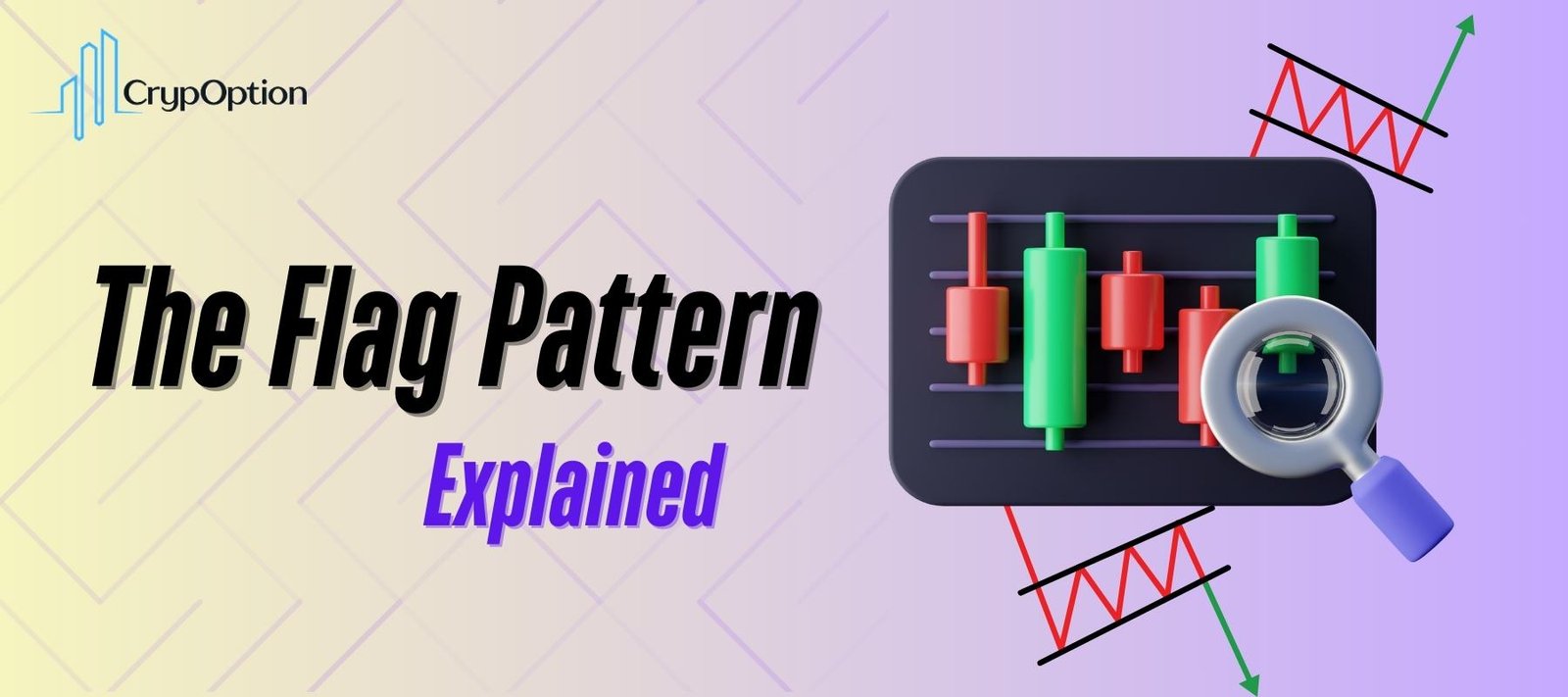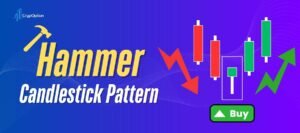Classical price action analysis has been around for decades. While some traders might prefer trading with indicators or even new methods like ICT Fair Value Gaps, trading chart patterns is still profitable (we will prove it). In this article, we will explain how to trade with one of the most common chart patterns, the flag pattern.
The flag pattern is a simple yet repeating chart pattern. We will begin the article by explaining what a flag pattern is and how to identify it. Then, we will introduce some flag trading pattern strategies with visuals. Finally, we’ll show you how to trade binary options using the flag chart pattern.
• The flag pattern is a continuation chart pattern consisting of a strong price move (flagpole) followed by a consolidation phase (flag) in a tight channel.
• There are two types of flag patterns: bullish flags (upward trend continuation) and bearish flags (downward trend continuation).
• A valid breakout occurs when a candle closes outside the flag pattern; wicks alone do not confirm a breakout.
• Stop-loss placement depends on risk tolerance: conservative SL is below/above the flag, while an aggressive SL is just below/above the breakout candle.
• Take-profit targets can be set based on the measured move method, targeting 50% of the impulsive move, or recent support/resistance levels.
• Flag patterns can be used in binary options trading by entering a trade when a candle closes outside the flag, with an expiration time of 3-5 minutes.
• Avoid trading in consolidating markets, as false breakouts are common; flag patterns work best in strongly trending markets.
• Using risk management is crucial—set stop losses and only risk a small percentage of your capital per trade.
• Confirm flag breakouts with indicators like volume, moving averages, or Fractal Chaos Bands to increase accuracy.
• Always practice with demo accounts before trading real funds; Quotex and Pocket Option offer free binary options demo accounts.
What Is a Flag Pattern in Trading?
A flag pattern is a price action chart pattern that shows a continuation of the current trend. The pattern resembles the shape of a flag, hence the name. It consists of a steep, short-term move (the flagpole) followed by a consolidation period with parallel trendlines (the flag). In fact, the flag pattern is very similar to a channel. We will explain the difference between channels and flags soon.
Flags can be considered as areas where the price is resting (correcting), before the next move further. A flag pattern can either be bullish or bearish, depending on the direction of the trend. Yet, the use case is identical. In both cases, the formation of a pattern points to a potential continuation of the original trend.
Now, if you have problems in trend identification, I suggest you check out this Supertrend indicator guide.
Understanding Bullish and Bearish Flag Patterns
As mentioned, there are two types of flags: The bullish flag and the bearish flag. Let’s explain both in detail.
What is a Bullish Flag Pattern?
Imagine a flag in the real world. It has a pole and a flag at the top. The bullish flag pattern looks the same. It consists of a bullish trend, which is the pole, and a tight correction, which is the bullish flag pattern. The bullish flag is essentially a gradual, bearish move in a tight channel. It is sometimes called a falling flag pattern.
When a bullish flag pattern forms, we expect the price to continue higher if the flag is broken to the upside. Of course, the length of the subsequent move is unknown. Yet, some traders anticipate the price to move as much as it did before the pattern formed (or a certain fraction of it, like 80%).
What is a Bearish Flag Pattern?
Now, imagine the same flag you did, but downward. This will be a bearish flag pattern. Once again, the pole will be the bearish move, and the flag will be a tight, bullish pullback inside a channel. The bearish flag pattern is also called a rising flag pattern.
Similar to a bullish flag, when a bearish flag pattern forms, the expectation is for the price to continue lower if it breaks the flag to the downside. Again, we cannot precisely say how much further the resulting move will go.
How to Identify Flag Patterns?
To identify a bullish flag pattern, here are the steps you should take:
- Find an impulsive, bullish move. The move should have considerable momentum.
- Look for a tight, falling channel, which will be our bullish flag pattern.
Now, to identify a bearish flag pattern, follow these steps:
- Look for an impulsive, bearish move. Again, the trend should have significant bearish momentum.
- Look for a tight, rising channel. It will be the bearish flag pattern.
The flag should not be too wide and too long. Some sources state that the flag should not be larger than 50% of the impulsive move. Then again, it’s not something you can’t identify with the naked eye.
Read More: You can use lagging indicators such as the “Zig Zag Indicator” to be sure about the trends and price patterns, too.
Flag Pattern Trading Strategy
Now that you know how to identify bullish and bearish flag patterns, it’s time to analyze the most common strategy.
In this strategy, we enter the breakout from the flag. In other words, the entry would be on the breakout candle’s close. Note that the breakout candle should close outside the flag. Wicks do not count.
You can also trade the third rejection from the higher boundary of a bearish flag, or the lower boundary of a bullish one. I personally don’t recommend it, unless you get a good reversal confirmation like a shooting star candle or a hammer candlestick pattern.
Back to our flag breakout strategy, here is a valid bullish flag pattern breakout, demonstrated on TradingView:
And here is a valid bearish flag pattern breakout:
The image below demonstrates a fully broken-down flag breakout trade:
Remember, a valid breakout from the flag pattern should occur with the breakout candle closing outside the flag. Wicks outside the pattern do not count.
Where to Place Your Stop Loss in the Flag Pattern Strategy?
Now that you know where to enter, you should learn about stop-loss placement. For a conservative stop loss, your SL order should be below the flag. On the other hand, an aggressive stop-loss level would be below the breakout candle’s low. This method would result in a much greater reward/risk ratio, but at the expense of winning probability. The price is much more likely to hit your stop loss when it’s this close. Take a look at the charts above for SL setting examples.
Where to Place Your Take Profit in the Flag Pattern Strategy?
When it comes to the take-profit order placement, there is much more variety. You can use the measured move method, where you will place the take profit as far as the length of the previous impulsive move. You can also set the TP at a fraction of the preceding move, for example, 50%. Yet, the method I like the most and personally use is targeting a recent high or low. Again, the charts above show examples of take-profit placements.
How to Trade Flag Patterns for Binary Options Trading?
As we mentioned, we cannot say for sure how much the price will move after a flag breakout. Yet, there’s one thing we can assume: the price will continue its move. This characteristic alone makes the flag chart pattern a great tool for binary options trading. If you are not familiar with binary options, check out our free beginner’s guide to binary options trading.
Here is a binary options trading strategy with the flag chart pattern:
- Look for an impulsive, bullish (bearish) move. To identify these moves, you can use tools like moving averages or the Supertrend indicator.
- Identify a bullish (bearish) flag and wait for a valid breakout. Remember, a breakout is valid when a candle closes outside the pattern.
- Your entry will be when the breakout candle closes. For bullish flags, you will execute a higher binary option. On the contrary, you should enter a lower binary option.
- Set the expiration time to 3-5 minutes later. Personally, I prefer a 5-minute binary option, as it gives the price more time to climb higher.
As you see, the flag strategy for binary options is very similar to other forms of trading. The only differences are that you have no stop loss or take profit orders, and there is an expiration time.
Meanwhile, remember to test any strategy you develop or learn from others. While top backtesting software tools are not adjusted for binary options, you can use demo accounts. Quotex and Pocket Options are two of the most reputable brokers that offer free binary options demo accounts.
Tips for Successful Flag Pattern Trading
To wrap up our article, here are some important tips to get the most out of flag trading:
Master Trend Identification
In order to trade the flag pattern, you should first identify the trend correctly. You can use classical market structure (higher highs and lows and vice versa) or indicators. Some of the best indicators for trend identification are moving averages, the Fractal Chaos Bands (which I like the most), or the ADX indicator. Either way, make sure that the move the flag resides in is impulsive.
Stay Away from Consolidating Markets
Flag patterns work best in trending markets. So, stay away from range-bound market conditions. This is the time when lots of flags form, but also when lots of them fail. Stick to trending markets to protect your capital.
Wait, Still Wait, Go
Be patient and wait for the price to break out of the flag pattern in the direction of the trend before entering a trade. Once again, the breakout is valid when the candle closes outside the flag. Moreover, do not enter pullback trades right when the price retests the flag. Wait for the candle to rebound. Finally, when you get the signal, do not hesitate and pull the trigger.
Use Proper Risk Management
While flag chart patterns are very easy to identify and trade, they do not guarantee anything. Every trading strategy has its flaws and shortcomings, and flags are no exception. So, use stop-loss orders and set them properly. For binary options trading, make sure to risk a small amount on each trade. You don’t want to blow your account in a couple of trades.
Confirm with Volume
Both breakout and pullback candles usually come with high volume. Some believe that volume is what confirms price moves. So, look at the volume indicator and verify whether the volume supports your idea or not.
Use Multiple Time Frames
Analyze the flag pattern on multiple time frames to confirm the validity of the pattern and the strength of the trend. Higher time frames can provide the overall trend direction with more precision.
Practice Makes Perfect
Such a cliche, isn’t it? But it’s true. You can never trade any strategy without properly practicing it. As a binary options trader, you can utilize free binary options demo accounts. DO NOT jump into real trading without enough experience and practice.
Trade at the Right Time
Timing is everything when it comes to binary options trading. Make sure to trade during the most volatile hours of the day and protect your capital from range-bound market conditions. Check out the best times to trade binary options, which are periods based on market sessions. ICT Killzones are also a great framework for timing your trades.
Read More: What Are ICT Order Blocks?
Conclusion
The flag pattern is one of the most common chart patterns. This is because every impulsive price move comes with a correction. So, mastering the flag chart pattern can be very beneficial for your analysis and trading. In this article, we thoroughly analyzed bullish and bearish flag patterns and showed how you can use them to trade any instrument, including binary options.
Yet, remember that no strategy guarantees a 100% winning ratio. So, in order to preserve your capital and stay in the game for the long term, make sure to manage your risk. Also, keep your emotions in check, as no matter how well you plan, your emotions can make you break all your rules.
FAQ
What is a flag pattern in trading?
A flag pattern is a price action chart pattern that indicates a continuation of the current trend. It consists of an impulsive price move followed by a tight consolidation inside parallel trendlines (the flag).
How can I identify bullish and bearish flag patterns?
To identify a bullish flag pattern, look for an impulsive bullish move followed by a tight, falling channel forming the flag. For a bearish flag pattern, identify an impulsive bearish move followed by a tight, rising channel, which is the bearish flag.
What are the common trading strategies for flag patterns?
Common trading strategies for flag patterns include the breakout strategy and the pullback strategy. In the breakout strategy, traders enter a trade on the breakout from the flag. Meanwhile, in the pullback strategy, they wait for a pullback to the flag after a valid breakout.
How can I trade flag patterns in binary options?
To trade flag patterns in binary options, look for an impulsive move, identify a flag pattern, and wait for a valid breakout. Enter a higher binary option for bullish flags and a lower binary option for bearish flags when the breakout candle closes outside the flag pattern.
Where should stop-loss and take-profit orders be placed in flag pattern trading?
For stop-loss placement, consider a conservative stop loss below the flag for bullish flags and above the flag for bearish flags. For take-profit orders, options include using the measured move method (setting a fraction of the preceding move) or targeting a recent high or low.
How can I trade flag chart patterns successfully?
Some key tips for successful flag pattern trading include avoiding consolidating markets, being patient for valid breakouts, using proper risk management with stop-loss orders, and practicing the strategy before real trading.
How to manage my risk when trading flag chart patterns?
Risk management is crucial when trading flag patterns or any strategy. It helps protect capital and ensures long-term sustainability in trading. Using stop-loss orders, proper position sizing, and managing emotions are essential for effective risk management.




